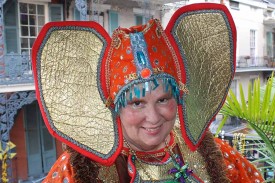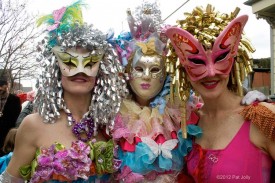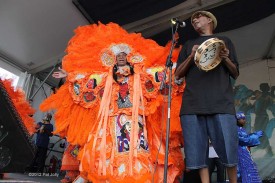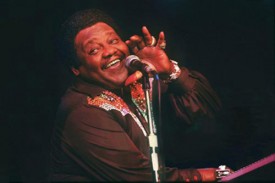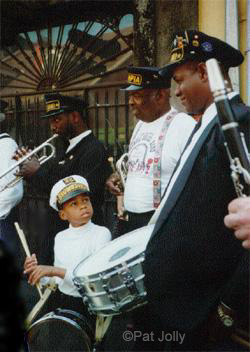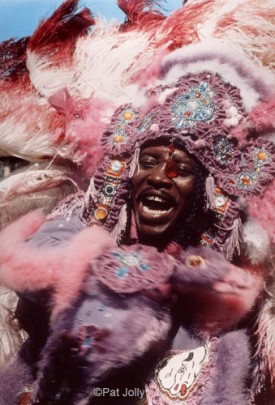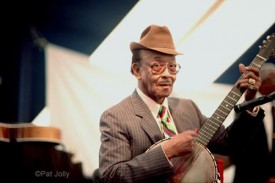A tireless advocate for local culture, Pat Jolly has made her mark as a photographer, arts educator, video producer and promoter of creative talent. Also well known for her impish joie de vivre, she grew up just a stone’s throw from the city’s primary Mardi Gras parade thoroughfare and remembers how the smoke from railroad flares and flambeau carriers—men wielding rows of kerosene burners mounted on poles with polished backboards to reflect the flames—would billow backward, so the parade floats would emerge from smoky darkness, to spellbinding effect.
The advocate as “fun-trepreneur”
Pat Jolly, aka the Funtrepreneur, on Carnival Day 2012
Approaching her milieu as a participant — and capturing glints of magic in the sensory cornucopia that is New Orleans.
Speaking of her passion for the cultural traditions of her native city, Pat Jolly says, “At every moment, I want to be participating.”
A 5th generation New Orleanian, Jolly grew up just a stone’s throw from the city’s primary Mardi Gras parade thoroughfare, antebellum St. Charles Avenue. She remembers how the smoke from railroad flares and flambeau carriers—men wielding rows of kerosene burners mounted on poles with polished backboards to reflect the flames—would billow backward, so the parade floats would emerge from smoky darkness. Seen through a child’s eyes, she says, the “etherealness” of the spectacle was “very magical.”
And very much a family affair. “I never missed a parade,” Jolly declares. “My family would go to every parade.”
Jolly—photographer, preservationist and arts educator—has been documenting the life and culture of New Orleans since the early 1980s. Her work has appeared in galleries, music clubs and other venues, as well as various media: magazines, books and Internet sites, plus music albums and CDs by the likes of Ellis Marsalis, Flora Purim, Patrice Fisher, Timothea, Deacon John, Paula and the Pontiacs, J. Monque’d and Walter “Wolfman” Washington.
By approaching her milieu, as she puts it, as “a participant, rather than a documentary artist,” Jolly is able to see beyond the surface and capture a glint of magic in her slices of the boisterous, mysterious character of local life.
“I’m taking photos of something that I’m part of,” she explains. “It’s sort of like an integral part of me.”
Indeed, her extensive body of work, consisting of over 100,000 images (slides, negatives, prints and digital files), reflects a relentless urge to immerse herself in the sensual cornucopia that is the Crescent City. For when it comes to events involving music and the arts, as well as a broad spectrum of community-oriented activities, few Orleanians are more plugged-in and passionately engaged than Pat Jolly. All of which affords her a unique opportunity—or as she puts it, “responsibility”—to record, and thus preserve, the culture she holds dear.
Flambeau carrier
The “etherealness” of Mardi Gras, having touched Jolly’s childhood imagination, became a compelling photographic subject.—Photo ©Pat Jolly
As with many natives, Jolly didn’t begin to truly appreciate the uniqueness of her hometown until moving away (she lived in Poughkeepsie, New York in the late 1960s, and Baton Rouge, Louisiana and Chicago in the 1970s). “I realized that we are a city with our own culture,” she once explained in an e-mail missive, “while everywhere else is an amalgamation of cultures.”
Motherhood—she has three children, all in their 30s, and two grandchildren—sparked Jolly’s initial interest in photography. She liked to take her brood to the photography studio, and bought her first camera in order to more thoroughly document their growth spurts.
However, her real passion was bridge. She began playing tournament bridge while living in New York, and once qualified to represent the United States at the World Bridge Olympiad in the mixed pairs event. In 1976, she achieved the distinction of becoming a Life Master, the highest duplicate bridge ranking attainable in the United States.
In between raising a family and traveling to bridge tournaments, Jolly volunteered as a docent at the Louisiana Arts & Science Center and as a patient liaison at the Women’s Hospital in Baton Rouge. “It was so exciting,” she says of her work at the hospital, “because I got to take the daddies to meet their new babies.” She also gave her time to The Phone, a crisis-intervention service, answering hotline calls from the anguished and suicidal.
Gravitating toward nonprofit cultural organizations in the late 1970s, Jolly was actively involved, from its inception, with the Louisiana Music Commission. She also was part of a group that tried (unsuccessfully) to establish a hall of fame for Louisiana musicians.
Maskers in the Society of St. Anne,
a Fat Tuesday marching group
In a boisterous culture of music, merriment and make-believe, Jolly and her camera find eyeball kicks aplenty—Photo ©Pat Jolly
Returning to New Orleans in 1979, following the end of her 14-year marriage, Jolly immersed herself in the local music scene—just as the city was rediscovering its uniquely rich musical heritage. She continued her involvement with the Louisiana Music Commission, which had recently been recognized and funded by the state, and joined the board of the Louisiana Music Association, a group formed to support songwriters.
Around the same time, she assisted New Orleans attorney and producer Ellis Pailet in his stewardship of the Governor’s Conference on Music. Jolly’s passion for promoting music at the grassroots level landed her a spot on the conference’s community involvement panel.
In 1981, after working for a local recording studio, Jolly joined the board of the Louisiana Jazz Federation. Thus began a 10-year stint producing “Jazz Awareness Month,” a citywide music festival co-sponsored by various community organizations.
She also directed projects for the Louisiana Jazz Network, an umbrella group that was formed to represent and promote local musicians. The network included the Arts Council of New Orleans, the Louisiana Division of the Arts, Musicians for Music, the Louisiana Jazz Federation, the New Orleans Jazz and Heritage Foundation and WWOZ-FM.
At the time she signed on with the federation, Jolly was attending around 80 music performances each month. Irked by the city’s lack of support for local talent, she found herself in violation of one of the “little rules” by which she lives: “You’re not allowed to complain about anything unless you’re actively doing something to rectify it.”
Big Chiefs Little Walter Cook and Howard Miller of the Creole Wild West Mardi Gras Indians performing at the 2012 New Orleans Jazz & Heritage Festival
Having served as staff photographer for the festival for nine years, taking photos for ID badges, Jolly still enjoys great access to performers on stage and behind the scenes.—Photo ©Pat Jolly
Result: a weekly listing of local music gigs that became known as The Jolly Jazz Calendar. Various local businesses let her use their copy machines gratis, and every week she’d distribute the 11″ x 17″ sheets free to friends and local music establishments—a welcome antidote to the often incomplete and inaccurate listings appearing in local publications.
The New Orleans Jazz and Heritage Foundation, a nonprofit organization affiliated with the New Orleans Jazz and Heritage Festival, eventually offered to help fund Jolly’s labor of love. Except for a brief period during which a foundation staffer assumed responsibility for the project, Jolly produced the calendar for more than eight years.
In 1987, a rejiggering of budget priorities at the foundation resulted in a loss of funding. By then the calendar had become something of an institution and was highly valued by local musicians. They rallied together to hold fundraisers, but after those proceeds were exhausted and Jolly had burned through most of her savings, she was forced to cease publication.
Jolly’s calendar won fans not only because of its thoroughness but also its format. Instead of listing gigs by club, it presented all of the available choices day-by-day. In 1988, Jan Ramsey, a local entrepreneur, asked Jolly—who was already an old hand at assembling music listings for Wavelength and Where magazines—to create a listing format for a new publication. To this day, Offbeat, now Louisiana’s premiere music magazine, adheres to Jolly’s day-by-day model.
Antoine “Fats” Domino
Jolly’s voluminous photographic collection, which is in need of cataloging, includes thousands of shots of New Orleans musicians — archival material she hopes to make available, via a cross-referenced, online database, to journalists, scholars and anyone else interested in exploring the culture of New Orleans.—Photo ©Pat Jolly
Jolly first started booking bands and performers in the early 1980s, working as a freelance consultant and talent coordinator. Her clients included local producers, as well as tourism and economic development agencies. In 1985, at the behest of the Arts Council of New Orleans, she served as a Jazz Administrator panelist—sharing her experiences producing cultural events on behalf of the community—at the Southern Arts Federation’s Southern Arts Exchange in Atlanta, Ga.
Later establishing a relationship with the Guatemala Ministry of Culture, Jolly arranged for New Orleans groups to perform at the Encuentro festival in Guatemala City. She also initiated a cultural exchange, bringing Guatemalan musicians to New Orleans to perform.
In 1990, in her capacity as production assistant for Centre d’Action Culturelle de Niort, in Niort, France, she helped coordinate an exhibition of Louisiana art, music and culture for Foire Exposition de Niort, la Louisiane a deux pas d’ici! New Orleans performers included the Treme Brass Band, Donald Harrison Sr.’s Guardians of the Flame Mardi Gras Indians and a jazz quintet. The following year, Producer Hannis Anrig, working through Jolly, arranged for a contingent of New Orleans musicians, including Doc Paulin’s Brass Band, Wanda Rouzan and Lynn August, to play a festival in Ascona, Switzerland. Also in 1991, Jolly arranged for New Orleans keyboard prodigy Davell Crawford, then 16 years old, to play his first European gig, in San Sebastian, Spain.
Olympia Brass Band
In the 1980s and 1990s, Jolly hooked up a top-notch parade of New Orleans bands and musicians with festival gigs in Europe, often serving as “road mother” — traveling with the entourage and coordinating with producers.—Photo ©Pat Jolly
Over the years, Jolly has worked closely with Raffaelle Barki of Accademia, a cultural organization in Milan, and Paolo Molena, Italy’s vice mayor of Sports, Culture and Recreation. In 1989, as U.S. Production Director for Accademia, she produced a New Orleans Mardi Gras presentation for Carnevale Ambrosio—which included a parade featuring six New Orleans brass bands and over 100 costumed participants—and then toured Italy with the musicians and New Orleans chef Austin Leslie. She returned the following year for the Carnevale with the New Leviathan Oriental Foxtrot Orchestra and four brass bands.
And for several years beginning in 1989, Jolly helped make the Vacanze Milano festival a prime venue for New Orleans talent. Her bookings at the festival included jazz bands, brass bands, gospel groups, street performers and Vernel Bagneris’s musical play And Further Mo’… .
Having brought an entourage of more than 50 musicians to Italy on three separate occasions, Jolly has established her credentials as a “road mother”—coordinating travel logistics and stage set-up, and attending to numerous other details.
Booking and touring with musicians and other performers afforded Jolly the opportunity to contribute to several Italian television productions. In 1988, the RAI 1 television network hosted a contest, “Premio Strada,” featuring street performers from all over the world. Jolly brought five acts from the United States to compete; a New Orleans artist, CoCoMo Joe, took first place.
The following year, Jolly selected eight New Orleans vocalists plus an eight-piece jazz band to perform at Milan’s Sotto le Stelle del Jazz, a two-night event at one of the grandest opera houses in Italy, the Teatro Nazionale. In Naples, she helped coordinate a related video production, “New Orleans Women in Jazz,” involving the RAI 1 television network. Another performance was taped for television with the cooperation of the Matera, Italy Chamber of Commerce. In 1999, Jolly, whose booking agency is called Jolly Jazz, brought a dancer, juggler and pan steel band to Italy to perform in a production that aired on the RAI 5 network.
Joyful noise in the 2012
Society of St. Anne parade
Jolly’s passion for promoting and documenting music at the grass-roots level has earned her a lot of cred within the community.—Photo ©Pat Jolly
During the 1980s, Jolly acquired extensive video production experience through her affiliation with the Louisiana Jazz Federation and its founder, grant writer and musician-composer Patrice Fisher. Among other projects, she produced Jazz Video Portraits, a series spotlighting New Orleans bands that won the Hometown Video Award from the National Federation of Local Cable Programmers (it was shown on 1,400 cable systems throughout the U.S.). For Cox Cable’s local Jazztown Series, Jolly produced segments on prominent musical families of New Orleans, among other subjects. She later received a grant from Cox, resulting in televised segments on brass bands, street performers and the late rhythm-and-blues legend Tommy Ridgely.
New Orleans in the 1990s witnessed a revival of interest in authentic brass band music, and Jolly was right in the thick of the action. As Music Captain for the satirical Krewe du Vieux for nine years, she booked numerous brass bands to perform in the group’s annual Mardi Gras procession, which rolls through the French Quarter three Saturdays before Fat Tuesday.
All the while, Jolly—who took her first photography classes as an undergraduate at Louisiana State University, in the mid-1970s—endeavored to sharpen her skills with a camera. While attending workshops at Anderson Ranch in Snowmass, Colorado, she found a mentor in the late Ernst Haas. Renowned for his dissolve work and experimental techniques, he was also, in Jolly’s opinion, “probably the foremost color photojournalist in the world.”
George runnin’ spyboy, a position roughly akin to that of a scout, with the White Eagles Mardi Gras Indians
Jolly aims to glean not only the external manifestations of creative expression but also the emotions and spontaneity exuded by the revelers behind the masks.—Photo ©Pat Jolly
Closer to home, Jolly has studied under Johnny Donnels, the noted New Orleans lensman; Aurthur Okazaki, head of photography at Tulane University; and—in classes at Tulane Photography & Imaging, which is affiliated with the Tulane Medical School—Mike Britt. Britt ran Delta Photo Lab, one of the first computerized photography facilities in the city, and it was through him that Jolly received her first exposure to digital imaging.
In endeavoring to capture the cultural panorama of New Orleans, Jolly has focused her lens on musicians, jazz funerals, second-line parades and the work of artists and costuming traditions that define the city’s culture of theatricality and masquerade.
Beginning in the late 1970s, she found herself drawn to a folk tradition dating back to the late 1800s—Mardi Gras Indians. These black and mixed-race celebrants, typically from poor neighborhoods, spend countless hours making elaborately plumed, intricately beaded “suits.” Their regalia and music and dance traditions, which animate Fat Tuesday, Super Sunday, St. Joseph’s Day and other festive occasions, have become emblazoned on the aesthetic and cultural consciousness of New Orleans.
Over the years, Jolly has become personally acquainted with some of the city’s leading Mardi Gras Indian practitioners. Her body of work includes many striking images of such noted tribes, or “gangs,” as the Wild Magnolias, Creole Wild West, Wild Tchoupitoulas and Yellow Pocahontas. For Jolly, the true spirit of Mardi Gras is revealed through costuming. During the season of merriment that culminates on Fat Tuesday, she covers a broad swath of the city, immersing herself in a smorgasbord of rituals and subcultures that thrive on creative expression. Her goal is twofold: to document the external manifestations of this creativity, and glean the emotions and spontaneity exuded by the revelers behind the masks.
St. Augustine High School
Marching One Hundred
The “look” of the sound through Jolly’s lens: “a blurry, throbbing image.”—Photo ©Pat Jolly
In 1990, five of Jolly’s Mardi Gras-related photos were included in a show entitled “Carnival Knowledge,” at Dashka Roth Gallery in New Orleans. The selections revealed her penchant for experimenting with color, movement and light dispersion. In a feature story about Jolly, the New Orleans Times-Picayune noted that for one of the shots, of the St. Augustine high school band’s drummers, she had moved the zoom lens out while keeping the shutter open, “capturing the look of the musicians’ sound with a blurry, throbbing image.”
Jolly’s facility with a camera, and her extensive ties to the New Orleans music community, eventually landed her a job with the New Orleans Jazz and Heritage Festival, where she served as staff photographer for nine years. (For the 1999 festival, Jolly was among three New Orleans photographers (along with Michael P. Smith and Syndey Byrd) whose work was featured in a 30th anniversary photo exhibit.) Over the years, her work has been featured in more than 70 exhibitions.
Meanwhile, Jolly was distinguishing herself at the Newcomb University Spring Arts Festival. Her awards, received over four consecutive years, included first place in photography (1993 and 1995) and second place in printmaking (1996).
For six months in 1995, the Hotel Inter-Continental presented a solo exhibition, entitled “Cultural Visions,” featuring Jolly’s photos of jazz funerals and second-line parades. (In New Orleans, neighborhood street processions involving brass bands and strutting, festively attired celebrants are known as second lines.) And in 1998, Jolly was one of the artists whose work the New Orleans African American Museum of Art, Culture and History—housed in the historic Treme Villa Meilleur—chose to highlight in its inaugural show. Other notable venues that have shown.
For many years, Jolly taught ceramics to inner-city youths through an innovative summer arts-education program sponsored by Young Audiences and the New Orleans Recreation Department (NORD). Her objective: “to inspire inspiration” and teach the “art of listening,” while emphasizing the importance of “ethical issues and accountability” as well as the viability of art as a profession. She also showcased the art and culture of New Orleans, as well the indigenous peoples of the Middle East, Africa, Mexico and Guatemala. Her approach was thematic, multicultural and participatory, with demonstrations by guest artists and performers, as well as slide shows of Jolly’s own work. In addition to ceramics, pupils got to try their hand at sand art, beading and making creations with yarn, among other mediums.
Danny Barker
One of Jolly’s all-time favorite New Orleanians, this legendary musician, writer, raconteur and jazz historian, after returning to native soil from New York in 1965, helped spark a revival of interest among younger musicians in the brass band tradition.—Photo ©Pat Jolly
The Jolly Jazz Calendar may be long gone, but since 1993, its namesake has been sending out e-mail blasts to keep people informed about performances and events, gatherings and fundraisers, art markets and exhibitions, funerals and celebrations, book signings, lost pets and much else. The tidbits sometimes include Jolly’s personal observations and musings, and many musicians have taken to asking her to spread the word about their gigs. After Hurricane Katrina, the free community email service grew in stature as people craved information about a city coming back to life.
Jolly has long applied her love for community outreach, fundraising and organizing on behalf of nonprofits including Friends of New Orleans Cemeteries, New Orleans Women in Music, Ladyfest and the YeMaYa parade. She’s also a judge for the Big Easy Entertainment Awards, an annual event sponsored by Gambit Weekly honoring local performers. Volunteering for the New Orleans Musicians’ Clinic, which provides assistance and funds to musicians in need of medical treatment, led to a job there after Hurricane Katrina setting up weekly gigs and finding housing for musicians.
Her “cred” with the music community is such that in 2004, she was able to pull off a remarkable feat: convincing about 100 musicians to create something for an art exhibit entitled Improvisation: Musicians as Artists. About three-quarters of the musicians involved hadn’t tried their hand at visual art since childhood.
After Katrina, beloved music legend Al “Carnival Time” Johnson told Pat how sad he was to have lost the many photos she’d given him over the years. That was her epiphany to realize her dream of digitally preserving and properly archiving her voluminous treasure trove. The Pat Jolly Photo Archive, for which she is seeking grant funding and donor support, is an ongoing project that aims to serve the needs of musicians, artists and culture bearers who too often don’t directly benefit from documentation of their performances and contributions. Jolly’s ultimate goal is for the archive to become a free public resource, available online to anyone wishing to explore the abundance of Louisiana and New Orleans culture.
The Funtrepreneur masking as the Duchess from Alice in Wonderland, Carnival Day 1999
Friendly with a wide swath of artists engaged in the creation of wearable regalia, Jolly has documented their creations extensively, giving her an intimate perspective on costuming in the Crescent City.
While many in the New Orleans community associate Jolly with her role as a tireless advocate for local culture, she’s at least as well known for her determination to enjoy life to the fullest. And indeed, the nicknames she has acquired over the years—e.g., Jollylama, The Funtrepreneur and The Night Mayor—testify to her impish joie de vivre. Optimism—something she likens to “willful naivete”—is what keeps her going.
“Why shouldn’t you be optimistic?” she asks. “Pessimistic is heavy. My goal is to make things light.”
MardiGrasTraditions.com

